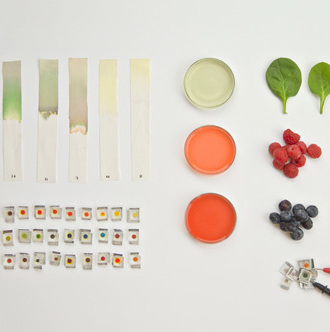The dutch MateriaalPrijs winner 2012 announced at the Dutch design week.
Imagine if every object worked as a solar cell?
In this collection everyday objects absorb energy from daylight.This solar glassware gathers energy from the light around it. Whether you are drinking from your glass or have left it on the side, it is constantly working to gather energy.
The solar cells are completely integrated into the objects themselves, a unique self-sufficient system. When you put the glass away, the specially designed cabinet itself collects and stores this energy; it’s a way to gather and harvest energy all within one room. The cabinet works as a battery; this power can be adapted in many ways, from charging your phone to powering a light source.
Within each glass is a photovoltaic layer of dye Synthesized Solar Cell. This means that the properties of colour are being used to create an electrical current. This technology was invented by Michael Graetzel at EPFL. It is a technique based on the process of photosynthesis in plants. Like the green chlorophyll which absorbs light energy, the colours in these cells collect energy.
Graetzel uses a porous Titanium dioxide layer soaked with photosensitive dye – a natural pigment extracted from the juice of blueberries or spinach. He discovered that the dye that gives the red or blue colour to berries, gives off an electron when light strikes it. One side of the glass is positive, the other negative and when the cell is exposed to light, the dye transmits its electrons to the titanium dioxide and releases an electronic current.
The glassware uses sunlight as a sustainable source of energy, but can also work under diffused light. This makes them much more efficient for use inside the home compared to standard solar panels, which only work in direct sunlight and are not suitable for indoor use.
Different colours mean different properties. Each colour has a unique wavelength and collects different currents. For example, blueberries and raspberries have their own voltages and levels of efficiency according to the colour spectrum.
Marjan van Aubel has been collaborating with Michael Graetzel lab at Ecole Polytechnic Federale Lausanne, Switzerland, Solaronix Lausanne, Switzerland, EPFL+ECAL Lab and with Imperial College London to develop and adapt the technologies for her glassware collection.

Comments by our Users
Be the first to write a comment for this item.